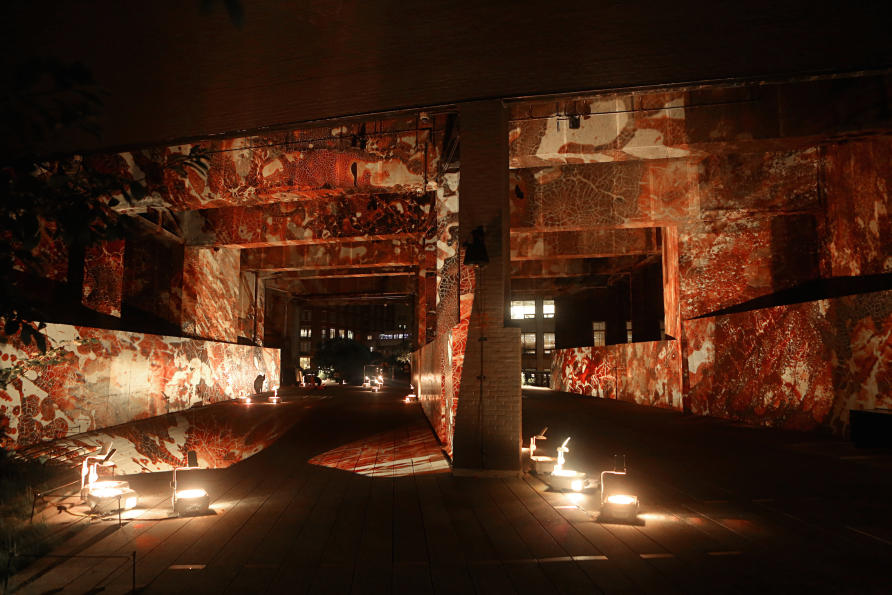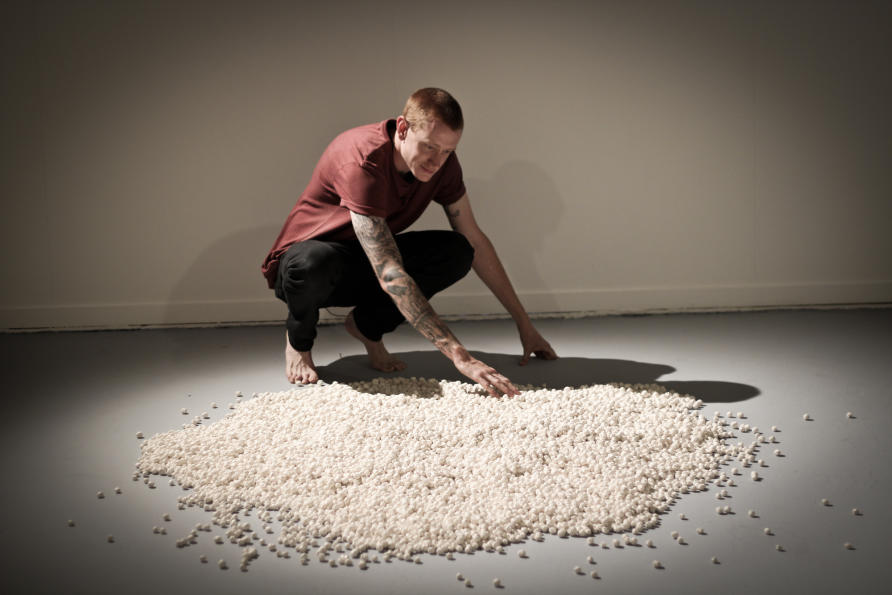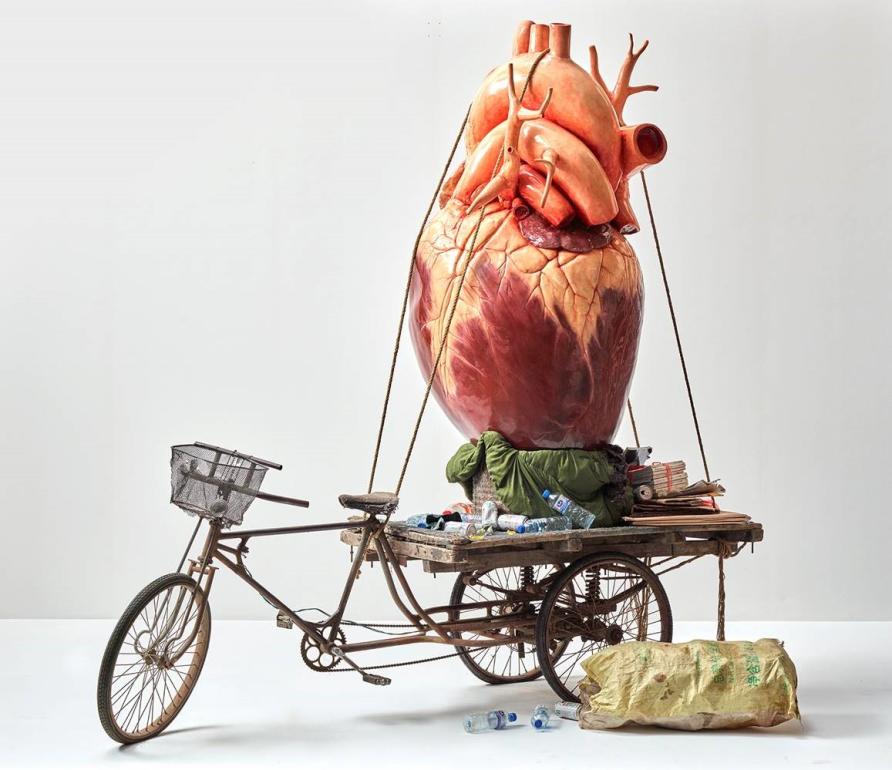Plastic objects made out of HIV and Hepatitis B infected blood are the creation of German artist Basse Stittgen and are just one of the many intriguing, confronting and beautiful artworks on display in Science Gallery Melbourne’s inaugural exhibition, Blood: Attract and repel. Here science and art meet in a way guaranteed to disturb and enlighten.
At the exhibition you will be able to not only feel blood, but also smell it and even taste it. You will be able to detect blood with light, have your blood type determined, and add the pulse in your finger to a fugue of pulses sounding through the gallery.
For Professor Sharon Lewin, a University of Melbourne infectious diseases physician and director of the Peter Doherty Institute for Infection and Immunity, who helped to select the artwork, Blood is a unique opportunity for art and science to confront the mysteries and fears that surround blood, and inform us along the way.
“I think if you asked people in the community whether they are at risk of catching HIV from sharing a cup they would say they are, and many others will feel slightly uncomfortable at the prospect. But there is no risk at all,” says Professor Lewin.
She says misconceptions, stoked by emotion and fear, drive the stigmas that are so often attached to people living with infections such as HIV.
“To lose that emotional reaction you have to understand and trust the evidence,” she says. “That is why science literacy is so important in understanding how it is we come to conclusions on what is safe or unsafe, and then trust the science. But I think in science we still have a long way to go in better communicating these messages.”
 Renowned New York artist Jordan Eagles projects powerful illuminations of blood from gay, bisexual and transgender men. For Nite Art on July 27 these projections will appear on the University of Melbourne’s Old Quad. Blood Illumination 2016 blood preserved on plexiglass, UV resin, analog overhead projectors, dimensions variable Installation view, High Line, New York, NY. Photo credit: David Meanix
Renowned New York artist Jordan Eagles projects powerful illuminations of blood from gay, bisexual and transgender men. For Nite Art on July 27 these projections will appear on the University of Melbourne’s Old Quad. Blood Illumination 2016 blood preserved on plexiglass, UV resin, analog overhead projectors, dimensions variable Installation view, High Line, New York, NY. Photo credit: David Meanix
She notes that in healthcare it has been recognised that exposure to blood puts people at risk of many potential blood-borne diseases, not just HIV. The adoption of universal precautions means all blood is treated the same when it comes to safety. The approach has also been adopted in sport where, under the blood rule, players bleeding from an injury must immediately seek treatment off the field.
“To a healthcare worker it should make no difference if a person is HIV positive or not because we treat all blood as infectious and take the necessary precautions,” Professor Lewin explains.
The risk of contracting HIV is limited to infection through unprotected sex and or by blood exposure such as sharing needles or having a blood transfusion. According to the US Centre for Disease Control, the risk of HIV infection from a needle stick penetrating the skin is just 23 out of every 10,000 people, or 0.23 per cent.
Blood is the inaugural exhibition of the University of Melbourne’s Science Gallery Melbourne – part of the world-wide Science Gallery International network of university-linked galleries that are dedicated to promoting public engagement with art and science. Blood, which has been curated by creative director Dr Ryan Jefferies, was inspired by the 2015 exhibition of the same name hosted by Science Gallery Dublin at Trinity College. Science Gallery London at King’s College is hosting its own Blood program this year.
One of Professor Lewin’s favourite works in the Science Gallery’s exhibition is One drop of blood by Queensland artist Daniel Elborne, who has made 20,000 porcelain white blood cells the size of pebbles. That is the approximate number of infection-fighting white blood cells in a single drop of blood in someone with a high-ranging white blood cell count. Viewers of the work are invited to take away the white pebbles in a symbolic representation of the falling white blood-cell count that cancer patients suffer when they undergo chemotherapy.
The work was inspired by Mr Elborne’s own mother’s fight with cancer, and the pebbles can only be taken in exchange for a donation to the National Breast Cancer Foundation.

“It is a beautiful and haunting representation of what happens to people during chemotherapy,” says Professor Lewin.
But just as science is uncovering the mystery and truth about blood, artist Robert Walton says that in many ways art had already anticipated the science. Ritualistic ideas around sharing blood, such as in the idea of blood brothers or the Christian ritual to symbolically share Christ’s blood, have in a sense been realised in the form of blood transfusions and blood donations.
“Through thousands of years of cultural practice and art we have always known how important blood is,” says Mr Walton, who lectures at the Victorian College of the Arts and Melbourne Conservatory of Music at the University of Melbourne and was also on the selection panel for Blood.
“The mystery of blood prefigures the scientific discoveries, and those mysteries have proven to be in many ways true.
“Blood is something that we share with others, it is something that can give life to others, and it does tell us about who we are in that that it holds our genetic inheritance,” says Mr Walton, whose own core art practice is as a director of experimental theatre and live art.
He says our reaction to blood is fascinating because it both repulses us and connects us. He suggests that the sight of blood disturbs us partly because we are accustomed to thinking of ourselves as separate and sealed off from the world and others. But when we bleed we are graphically reminded of our own bodies and our vulnerability.
“Our cultures sometimes make us forget that we are part of the animal kingdom, and make us think that we are detached from our bodies. But when blood spurts out of a wound it becomes the liquid that connects us to the outside world, and it is horrifying. We imagine our life trickling away,” he says.
 Recyling – Bao Yiluo. Recycling is an enormous fibreglass human heart tied onto the back of a san lun che, a popular multi-purpose tricycle often used for carrying recycled paper, cardboard and firewood in China. Thousands of organs are transplanted in China every year, but the lack of reliable information about their source raises serious ethical and legal questions. This work is part of the White Rabbit Collection, Sydney. Image: Courtesy of the artist and White Rabbit Collection, Sydney
Recyling – Bao Yiluo. Recycling is an enormous fibreglass human heart tied onto the back of a san lun che, a popular multi-purpose tricycle often used for carrying recycled paper, cardboard and firewood in China. Thousands of organs are transplanted in China every year, but the lack of reliable information about their source raises serious ethical and legal questions. This work is part of the White Rabbit Collection, Sydney. Image: Courtesy of the artist and White Rabbit Collection, Sydney
But blood is also a vehicle for building empathy and awareness. The empathetic powers of blood, he says, have been famously explored by such performance artists such as Franko B, Ron Athey, Kira O’Reilly, and Marina Abramović who have purposely made themselves bleed in front of a close-up audience.
“When we see someone bleeding it creates a huge amount of empathy when we realise that like us, blood courses through another being’s veins. The reality of inhabiting a fragile, bloody body, connects us,” he says. “And then that awareness can prompt us further to think of the bigger picture, and how all creatures are connected.”
Walton says one of blood’s most enduring powers is the way it has come to symbolise our common humanity in the face of cultural prejudices towards stigmatised groups.
Perhaps one of the most well know examples in English are the lines of Shylock the Jew in Shakespeare’s play The Merchant of Venice.
“If you prick us, do we not bleed?”
“A lot of performance artists with blood borne diseases like HIV use blood to remind us again and again that we all share an experience of existing as a living, breathing, bleeding body,” says Mr Walton.
“We all feel pain, and we all need love and warmth. It is the human condition.”
The Doherty Institute is a joint venture of the University of Melbourne and Royal Melbourne Hospital.
Science Gallery’s Blood: Attract and Repel exhibition opens 2 August and runs through to 22 September at the Frank Tate Building at the University of Melbourne, Parkville.
Banner image: You Beaut, Hotham Street Ladies, 2014. Image courtesy of the artist
This article was first published on Pursuit. Read the original article.”